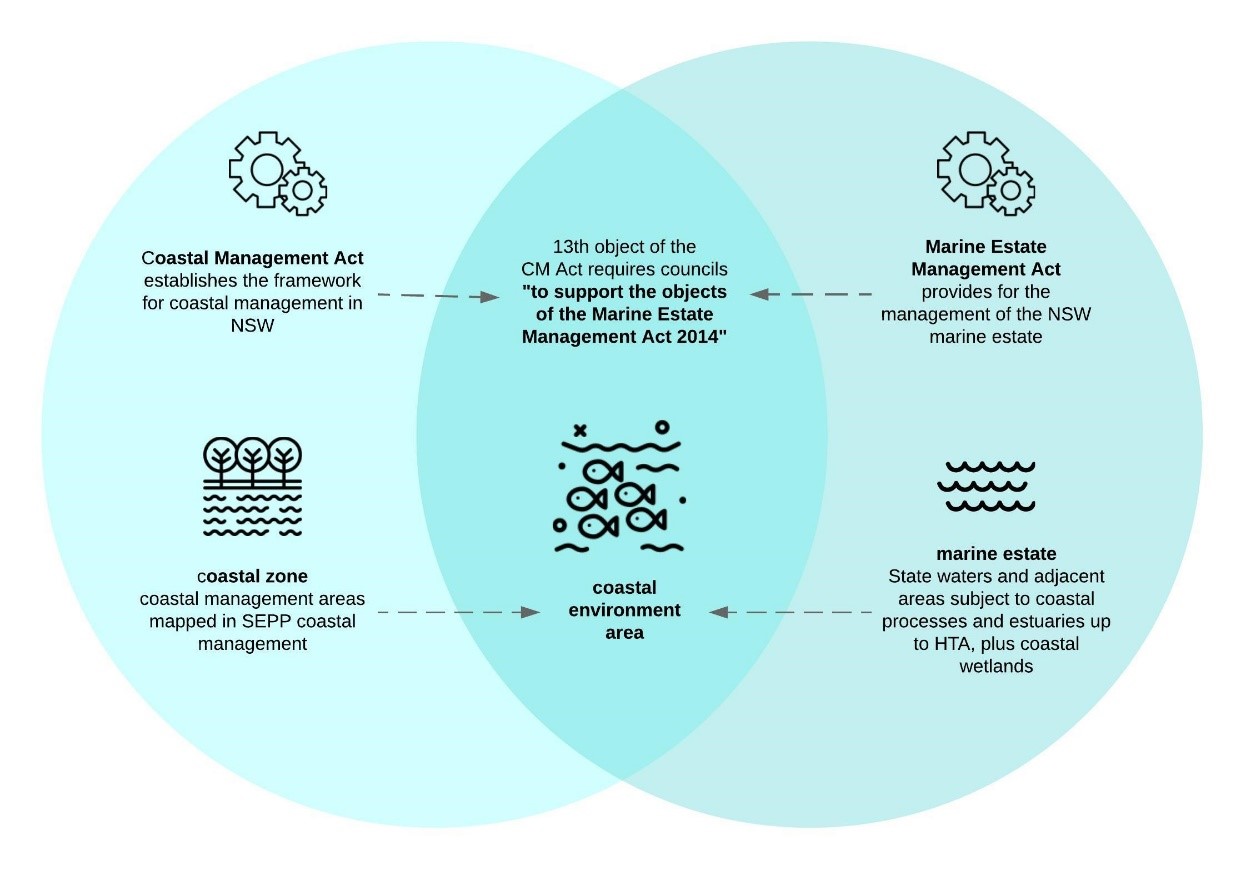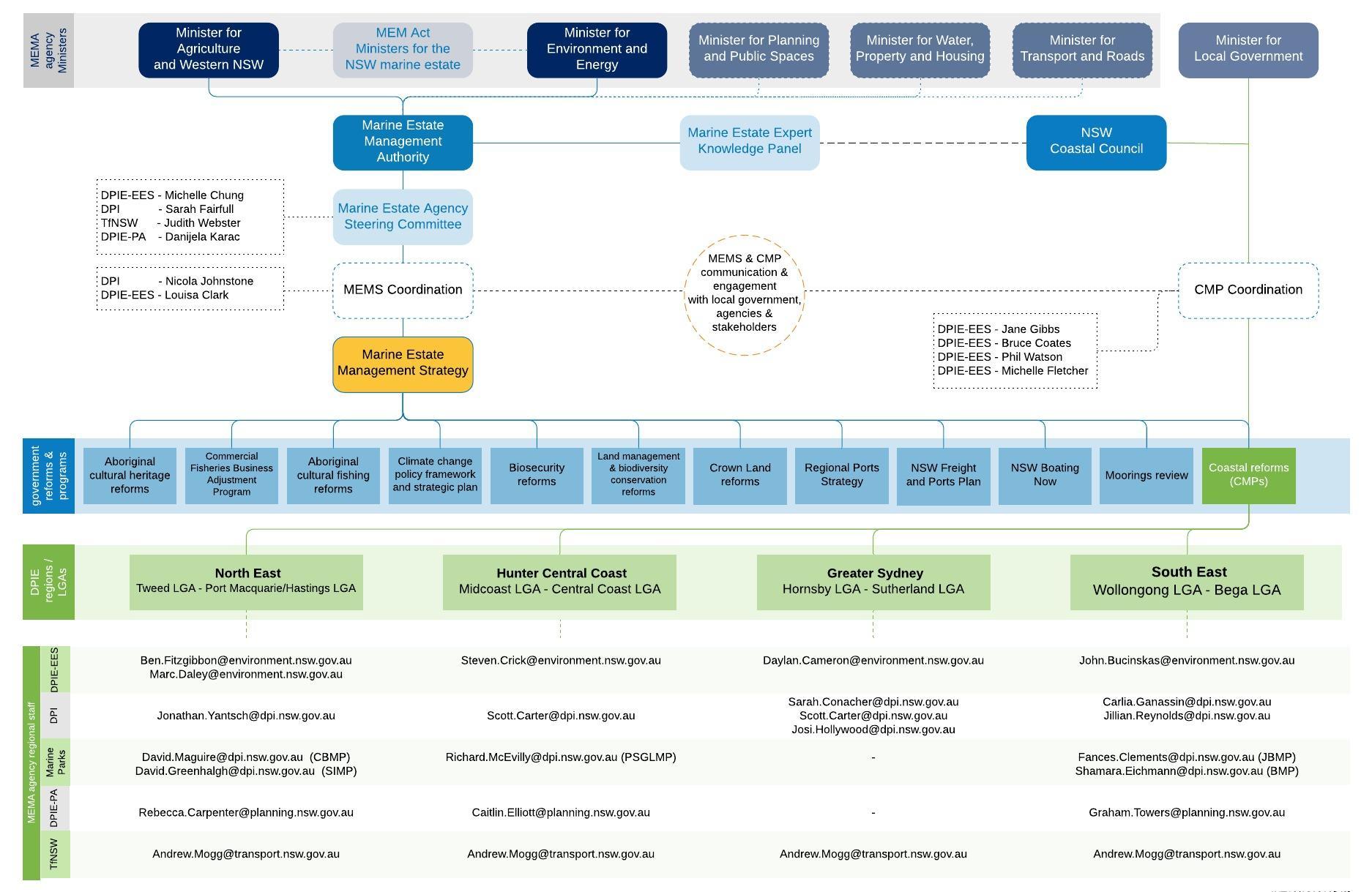FAQs about the Strategy for local government
The NSW marine estate
The marine estate is all coastal waters of NSW from the Queensland border to the Victorian border and out to three nautical miles. It includes estuaries to their tidal limits, coastal wetlands and lands immediately adjacent to, or in the immediate proximity of NSW coastal waters including beaches, dunes, headlands and rock platforms.
What is the Marine Estate Management Strategy?
The Marine Estate Management Strategy (PDF, 12612.84 KB) (Strategy) is a framework for the NSW Government to coordinate the management of the marine estate between 2018 and 2028. The Strategy identifies actions to address statewide priority threats (PDF, 5144.96 KB) to the marine estate.
The Marine Estate Management Authority (the Authority) is comprised of four agencies with responsibilities in marine estate management:
- Department of Primary Industries (DPI)
- Department of Planning and Environment – Energy, Environment and Science (DPE-EES)
- Department of Planning and Environment – Planning and Assessment (DPE-PA)
- Transport for NSW (TfNSW)
The Authority developed the Strategy following significant input from stakeholders, including local government, peak interest groups and the broader community. Some projects will occur in specific locations along the coast such as natural oyster reef restoration in Port Stephens. Other projects will have benefits across NSW, such as a Marine Estate Education Strategy or the application of a risk-based framework for water quality in estuaries.
How has local government been involved in delivering the Strategy?
The Authority has engaged with local councils since the early stages of the development of the Strategy. Since its release in August 2018, staff implementing the Strategy have been liaising with council staff to identify partnerships, plan projects and ensure they are relevant to, and complement council programs where possible. Many coastal councils are actively engaged in delivering projects underway.
Does the Strategy have funding for local government projects?
The Strategy is not a grants program and therefore local councils cannot apply directly for funding under the Strategy actions. The exception is the Boating Now Program in Initiative 7, as Transport for NSW provides grant funding to Councils for the delivery of maritime infrastructure.
Council input into the development of the Strategy has helped the Authority identify many projects that address the statewide priority threats. State agencies are funded to coordinate the 100+ projects underway. Project leads are working closely with all partners, including local government, to improve the health of the marine estate to benefit the community.
Regional staff of the marine estate agencies (Figure 3) will be the key contacts for councils to ensure the integration of the Strategy with CMPs under development. Regional staff will facilitate the provision of consistent and agreed advice and guidance on behalf of the Authority to councils.
How and where is the Strategy being implemented?
The Implementation Plan (PDF, 4340.52 KB) outlines how the NSW Government will deliver the initiatives and actions in a coordinated and streamlined way. A map (PDF, 1591.34 KB) is available of current projects in each local government area.
How does the Strategy and TARA link with Coastal Management Programs?
Council Coastal Management Programs (CMPs) are strongly aligned with improving outcomes for the marine estate. CMPs are required to support the objectives of the Marine Estate Management Act 2014. The development and implementation of the Strategy and CMPs are bound by legislation and both rely on a risk-based approach (Figure 1).
As councils develop their CMPs through their five stages (Figure 2), they should consider:
- the TARA - which is a key resource for considering priority threats on estuaries and coastal and marine areas during preparation of CMP Scoping Studies
- aligning CMP actions with the initiatives and actions in the Strategy
- outcomes and key learnings from projects piloted in early stages of the Strategy to help inform the design and implementation of local management actions (including those in CMPs)
- data collected to monitor and evaluate Strategy outcomes (for example water quality data) which can inform CMP delivery.
Who can I contact for more information?
Authority agency representatives are located in four coastal regions along the NSW coast. For more information on how to integrate Strategy actions into CMPs your first point of contact is your nearest regional Authority agency representative (Figure 3).
If you require information, please contact the program leaders:
| Nicola Johnstone, DPI (Strategy) | nicola.johnstone@dpi.nsw.gov.au |
| Louisa Clark, DPE – EES (Strategy) | louisa.clark@environment.nsw.gov.au |
| Michelle Fletcher, DPE – EES (CMPs) | michelle.fletcher@environment.nsw.gov.au |
Figure 1. The Strategy and Coastal Management Programs are bound by legislation
Figure 2. Ideas for integrating the NSW Marine Estate Management Strategy with Coastal Management Programs
| 1. Scoping |
|
| 2. Determining risks, vulnerabilities and opportunities |
|
| 3. Identify and evaluate options |
|
| 4. Prepare, exhibit, finalise and adopt CMP |
|
| 5. Implement, monitor, evaluate and report |
|
Acronyms and links
- CMP - Coastal Management Program
- MEEKP - Marine Estate Expert Knowledge Panel
- MEMA - Marine Estate Management Authority
- TARA - Threat and Risk Assessment
Figure 3. Strategy and Coastal Management Programs integration and contacts

